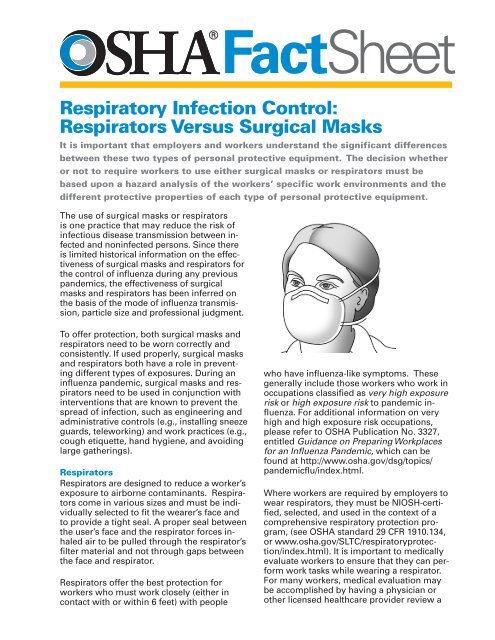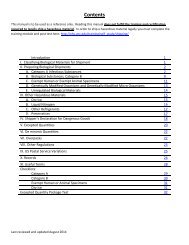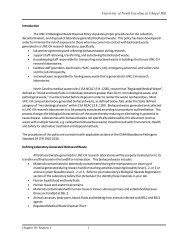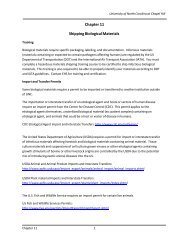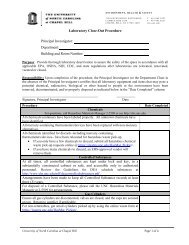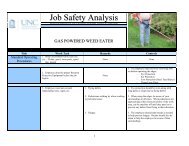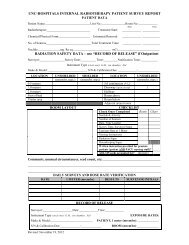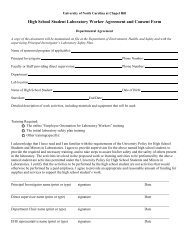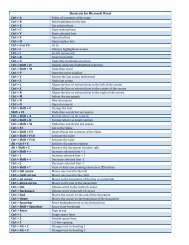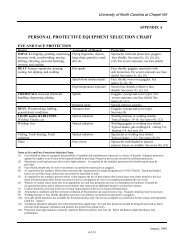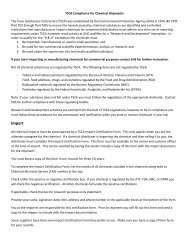Respiratory Infection Control: Respirators Versus Surgical ... - OSHA
Respiratory Infection Control: Respirators Versus Surgical ... - OSHA
Respiratory Infection Control: Respirators Versus Surgical ... - OSHA
Create successful ePaper yourself
Turn your PDF publications into a flip-book with our unique Google optimized e-Paper software.
FactSheet<br />
<strong>Respiratory</strong> <strong>Infection</strong> <strong>Control</strong>:<br />
<strong>Respirators</strong> <strong>Versus</strong> <strong>Surgical</strong> Masks<br />
It is important that employers and workers understand the significant differences<br />
between these two types of personal protective equipment. The decision whether<br />
or not to require workers to use either surgical masks or respirators must be<br />
based upon a hazard analysis of the workers’ specific work environments and the<br />
different protective properties of each type of personal protective equipment.<br />
The use of surgical masks or respirators<br />
is one practice that may reduce the risk of<br />
infectious disease transmission between infected<br />
and noninfected persons. Since there<br />
is limited historical information on the effectiveness<br />
of surgical masks and respirators for<br />
the control of influenza during any previous<br />
pandemics, the effectiveness of surgical<br />
masks and respirators has been inferred on<br />
the basis of the mode of influenza transmission,<br />
particle size and professional judgment.<br />
To offer protection, both surgical masks and<br />
respirators need to be worn correctly and<br />
consistently. If used properly, surgical masks<br />
and respirators both have a role in preventing<br />
different types of exposures. During an<br />
influenza pandemic, surgical masks and respirators<br />
need to be used in conjunction with<br />
interventions that are known to prevent the<br />
spread of infection, such as engineering and<br />
administrative controls (e.g., installing sneeze<br />
guards, teleworking) and work practices (e.g.,<br />
cough etiquette, hand hygiene, and avoiding<br />
large gatherings).<br />
<strong>Respirators</strong><br />
<strong>Respirators</strong> are designed to reduce a worker’s<br />
exposure to airborne contaminants. <strong>Respirators</strong><br />
come in various sizes and must be individually<br />
selected to fit the wearer’s face and<br />
to provide a tight seal. A proper seal between<br />
the user’s face and the respirator forces inhaled<br />
air to be pulled through the respirator’s<br />
filter material and not through gaps between<br />
the face and respirator.<br />
<strong>Respirators</strong> offer the best protection for<br />
workers who must work closely (either in<br />
contact with or within 6 feet) with people<br />
who have influenza-like symptoms. These<br />
generally include those workers who work in<br />
occupations classified as very high exposure<br />
risk or high exposure risk to pandemic influenza.<br />
For additional information on very<br />
high and high exposure risk occupations,<br />
please refer to <strong>OSHA</strong> Publication No. 3327,<br />
entitled Guidance on Preparing Workplaces<br />
for an Influenza Pandemic, which can be<br />
found at http://www.osha.gov/dsg/topics/<br />
pandemicflu/index.html.<br />
Where workers are required by employers to<br />
wear respirators, they must be NIOSH-certified,<br />
selected, and used in the context of a<br />
comprehensive respiratory protection program,<br />
(see <strong>OSHA</strong> standard 29 CFR 1910.134,<br />
or www.osha.gov/SLTC/respiratoryprotection/index.html).<br />
It is important to medically<br />
evaluate workers to ensure that they can perform<br />
work tasks while wearing a respirator.<br />
For many workers, medical evaluation may<br />
be accomplished by having a physician or<br />
other licensed healthcare provider review a
espiratory questionnaire completed by the<br />
worker (found in Appendix C of <strong>OSHA</strong>’s<br />
<strong>Respiratory</strong> Protection standard, 29 CFR<br />
1910.134) to determine if the worker can be<br />
medically cleared to use a respirator. Employers<br />
who have never before needed to<br />
consider a respiratory protection plan should<br />
note that it can take time to choose an appropriate<br />
respirator to provide to workers; arrange<br />
for a qualified trainer; and provide training, fit<br />
testing and medical evaluation for their workers.<br />
If employers wait until an influenza pandemic<br />
occurs, they may be unable to implement an<br />
adequate respiratory protection program in a<br />
timely manner.<br />
<strong>Surgical</strong> Masks<br />
<strong>Surgical</strong> masks are used as a physical barrier<br />
to protect the user from hazards, such as<br />
splashes of large droplets of blood or body<br />
fluids.<br />
<strong>Surgical</strong> masks also protect other people<br />
against infection from the person wearing<br />
the surgical mask. Such masks trap large particles<br />
of body fluids that may contain bacteria<br />
or viruses expelled by the wearer.<br />
• Worn by healthcare providers to prevent accidental<br />
contamination of patients’ wounds<br />
by the organisms normally present in mucus<br />
and saliva.<br />
• Worn by workers to protect themselves<br />
from splashes or sprays of blood or bodily<br />
fluids; they may also keep contaminated fingers/hands<br />
away from the mouth and nose.<br />
<strong>Surgical</strong> masks are not designed or certified<br />
to prevent the inhalation of small airborne<br />
contaminants. These particles are not visible<br />
to the naked eye but may still be capable of<br />
causing infection. <strong>Surgical</strong> masks are not designed<br />
to seal tightly against the user’s face.<br />
During inhalation, much of the potentially<br />
contaminated air can pass through gaps between<br />
the face and the surgical mask and not<br />
be pulled through the filter material of the<br />
mask. Their ability to filter small particles<br />
varies significantly based upon the type of<br />
material used to make the surgical mask, so<br />
they cannot be relied upon to protect workers<br />
against airborne infectious agents. Only surgical<br />
masks that are cleared by the U.S. Food<br />
and Drug Administration to be legally marketed<br />
in the United States have been tested<br />
for their ability to resist blood and body fluids.<br />
<strong>Surgical</strong> masks are used for several different<br />
purposes, including the following:<br />
• Placed on sick people to limit the spread of<br />
infectious respiratory secretions to others.<br />
This is one in a series of informational fact sheets highlighting <strong>OSHA</strong> programs, policies or<br />
standards. It does not impose any new compliance requirements. For a comprehensive list of<br />
compliance requirements of <strong>OSHA</strong> standards or regulations, refer to Title 29 of the Code of Federal<br />
Regulations. This information will be made available to sensory impaired individuals upon request.<br />
The voice phone is (202) 693-1999; teletypewriter (TTY) number: (877) 889-5627.<br />
For more complete information:<br />
U.S. Department of Labor<br />
www.osha.gov<br />
(800) 321-<strong>OSHA</strong><br />
DSG 5/2009


